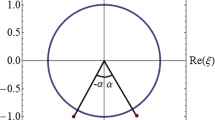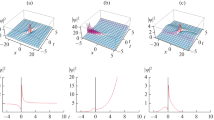Abstract
By solving analytically two 1D coupled Gross–Pitaevskii equations with a time-dependent harmonic trap, we find Peregrine solutions that can be effectively controlled by modulating the external potential frequency. Indeed, one observes the onset of instability in the dynamical system as the frequency is varied. This leads to the possibility of stabilizing the Peregrine solitons.







Similar content being viewed by others
REFERENCES
S. Wabnitz, Ch. Finot, J. Fatome, and G. Millot, “Shallow water rogue wavetrains in nonlinear optical fibers,” Phys. Lett. A.377 (12), 932–939 (2013). https://doi.org/10.1016/j.physleta.2013.02.007
J. M. Dudley, G. Genty, and B. J. Eggleton, “Harnessing and control of optical rogue waves in supercontinuum generation,” Opt. Express.16 (6), 3644–3651 (2008). https://doi.org/10.1364/OE.16.003644
R. Driben and I. Babushkin, “Accelerated rogue waves generated by soliton fusion at the advanced stage of supercontinuum formation in photonic-crystal fibers,” Opt. Lett. 37 (24), 5157–5159 (2012). https://doi.org/10.1364/OL.37.005157
A. Montina, U. Bortolozzo, S. Residori, and F. T. Arecchi, “Non-Gaussian statistics and extreme waves in a nonlinear optical cavity,” Phys. Rev. Lett. 103 (17), 173901 (2009). https://doi.org/10.1103/PhysRevLett.103.173901
S. Residori, U. Bortolozzo, A. Montina, F. Lenzini, and F. T. Arecchi, “Rogue waves in spatially extended optical systems,” Fluctuation Noise Lett. 11 (1), 1240014 (2012). https://doi.org/10.1142/S0219477512400147
D. H. Peregrine, “Water waves, nonlinear Schrödinger equations and their solutions,” J. Austral. Math. Soc. Ser. B.25 (1), 16–43 (1983). https://doi.org/10.1017/S0334270000003891
N. Akhmediev, A. Ankiewicz, and M. Taki, “Waves that appear from nowhere and disappear without a trace,” Phys. Lett. A.373 (6), 675–678 (2009). https://doi.org/10.1016/j.physleta.2008.12.036
C. Bonatto, M. Feyereisen, S. Barland, M. Giudici, C. Masoller, J. R. Rios Leite, and J. R. Tredicce, “Deterministic optical rogue waves,” Phys. Rev. Lett. 107 (5), 053901 (2011). https://doi.org/10.1103/PhysRevLett.107.053901
F. Baronio, A. Degasperis, M. Conforti, and S. Wabnitz, “Solutions of the vector nonlinear Schrödinger equations: Evidence for deterministic rogue waves,” Phys. Rev. Lett. 109 (4), 044102 (2012). https://doi.org/10.1103/PhysRevLett.109.044102
D. J. Kedziora, A. Ankiewicz, and N. Akhmediev, “Second-order nonlinear Schrödinger equation breather solutions in the degenerate and rogue wave limits,” Phys. Rev. E.85 (6), 066601 (2012). https://doi.org/10.1103/PhysRevE.85.066601
P. Gaillard, “Degenerate determinant representation of solutions of the nonlinear Schrödinger equation, higher order Peregrine breathers and multi-rogue waves,” J. Math. Phys. 54 (1), 013504 (2013). https://doi.org/10.1063/1.4773096
A. Ankiewicz, J. M. Soto-Crespo, and N. Akhmediev, “Rogue waves and rational solutions of the Hirota equation,” Phys. Rev. E.81 (4), 046602 (2010). https://doi.org/10.1103/PhysRevE.81.046602
Y. Tao and J. He, “Multisolitons, breathers, and rogue waves for the Hirota equation generated by the Darboux transformation,” Phys. Rev. E.85 (2), 026601 (2012). https://doi.org/10.1103/PhysRevE.85.026601
Li-Chen Zhao and Jie Liu, “Localized nonlinear waves in a two-mode nonlinear fiber,” J. Opt. Soc. Am. B: Opt. Phys. 29 (11), 3119–3127 (2012). https://doi.org/10.1364/JOSAB.29.003119
Li-Chen Zhao and Jie Liu, “Rogue-wave solutions of a three-component coupled nonlinear Schrödinger equation,” Phys. Rev. E.87 (1), 013201 (2013). https://doi.org/10.1103/PhysRevE.87.013201
F. Dalfovo, S. Giorgini, L. P. Pitaevskii, and S. Stringari, “Theory of Bose–Einstein condensation in trapped gases,” Rev. Mod. Phys. 71 (3), 463–512 (1999). https://doi.org/10.1103/RevModPhys.71.463
K. Staliunas, S. Longhi, and D. J. de Valcárcel, “Faraday patterns in Bose–Einstein condensates,” Phys. Rev. Lett. 89 (21), 210406 (2002). https://doi.org/10.1103/PhysRevLett.89.210406
F. Kh. Abdullaev, J. G. Caputo, R. A. Kraenkel, and B. A. Malomed, “Controlling collapse in Bose–Einstein condensates by temporal modulation of the scattering length,” Phys. Rev. A.67 (1), 013605 (2003). https://doi.org/10.1103/PhysRevA.67.013605
Zai-Dong Li, Cong-Zhe Huo, Qiu-Yan Li, Peng-Bin He, and Tian-Fu Xu, “Symmetry and asymmetry rogue waves in two-component coupled nonlinear Schrödinger equations,” Chin. Phys. B.27 (4), 040505 (2018). https://doi.org/10.1088/1674-1056/27/4/040505
G. P. Agrawal, Nonlinear Fibre Optics (Academic, New York, 2006).
S. V. Manakov, “On the theory of two-dimensional stationary self-focusing of electromagnetic waves,” Sov. Phys.-JETP. 38 (2), 248–253 (1974).
D. J. Kaup and B. A. Malomed, “Soliton trapping and daughter waves in the Manakov model,” Phys. Rev. A.48 (1), 599–604 (1993). https://doi.org/10.1103/PhysRevA.48.599
V. B. Matveev and M. A. Salle, Darboux Transformations and Solitons (Springer, Berlin, 1991).
N. Vishnupriya, M. Senthilvelan, and M. Lakshmanan, “Breathers and rogue waves: Demonstration with coupled nonlinear Schrödinger family of equations,” Pramana –J. Phys. 84 (3), 339–352 (2015). https://doi.org/10.1007/s12043-015-0937-4
R. Radha and P. S. Vinayagam, “Stabilization of matter wave solitons in weakly coupled atomic condensates,” Phys. Lett. A.376 (8-9), 944–949 (2012). https://doi.org/10.1016/j.physleta.2012.01.029
ACKNOWLEDGMENTS
The authors HCS, MB and HB acknowledge the support provided by Hassiba Benbouali University of Chlef and the Ministry of Higher Education and Scientific Research of Algeria through the grants HB00L02UN020120180002/2018-2019. The authors PSV and UAK acknowledge the support of UAE University through the grants UPAR(7)-2015, UPAR(4)-2016, and UPAR(6)-2017. PSV wishes to extend his gratitute to the Principal of PSG College of Arts and Sciences, Coimbatore, Tamilnadu, India for her continuous support, motivation and facilities.
Author information
Authors and Affiliations
Corresponding author
APPENDIX: FROM GPE TO MANAKOV SYSTEM
APPENDIX: FROM GPE TO MANAKOV SYSTEM
Similarity transformation and analytical setup from GPE to Manakov system: we apply the following transformation to Eqs. (1):
where
Substituting the above transformation given by \({{\psi }_{1}}\) and \({{\psi }_{2}}\) in Eqs. (1) and reinforcing the following constraints:
will reduce the coupled GP equations to the coupled NLS equations (2a, 2b) [20–22]
About this article
Cite this article
Chaachoua Sameut, H., Pattu, S., Al Khawaja, U. et al. Peregrine Soliton Management of Breathers in Two Coupled Gross–Pitaevskii Equations with External Potential. Phys. Wave Phen. 28, 305–312 (2020). https://doi.org/10.3103/S1541308X20030036
Received:
Revised:
Accepted:
Published:
Issue Date:
DOI: https://doi.org/10.3103/S1541308X20030036




